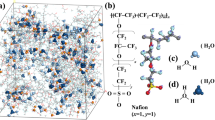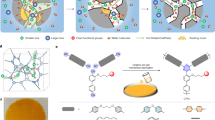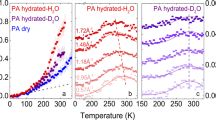Abstract
Semipermeable polymeric anion exchange membranes are essential for separation, filtration and energy conversion technologies including reverse electrodialysis systems that produce energy from salinity gradients, fuel cells to generate electrical power from the electrochemical reaction between hydrogen and oxygen, and water electrolyser systems that provide H2 fuel. Anion exchange membrane fuel cells and anion exchange membrane water electrolysers rely on the membrane to transport OH− ions between the cathode and anode in a process that involves cooperative interactions with H2O molecules and polymer dynamics. Understanding and controlling the interactions between the relaxation and diffusional processes pose a main scientific and critical membrane design challenge. Here quasi-elastic neutron scattering is applied over a wide range of timescales (100–103 ps) to disentangle the water, polymer relaxation and OH− diffusional dynamics in commercially available anion exchange membranes (Fumatech FAD-55) designed for selective anion transport across different technology platforms, using the concept of serial decoupling of relaxation and diffusional processes to analyse the data. Preliminary data are also reported for a laboratory-prepared anion exchange membrane especially designed for fuel cell applications.
This is a preview of subscription content, access via your institution
Access options
Access Nature and 54 other Nature Portfolio journals
Get Nature+, our best-value online-access subscription
$29.99 / 30 days
cancel any time
Subscribe to this journal
Receive 12 print issues and online access
$259.00 per year
only $21.58 per issue
Buy this article
- Purchase on Springer Link
- Instant access to full article PDF
Prices may be subject to local taxes which are calculated during checkout





Similar content being viewed by others
Data availability
All data needed to evaluate the conclusions in the paper are present in the paper and/or the Supplementary Information. Additional data related to this paper may be requested from the authors. Source data are provided with this paper.
References
Zlotorowicz, A., Strand, R. V., Burheim, O. S., Wilhelmsen, Ø. & Kjelstrup, S. The permselectivity and water transference number of ion exchange membranes in reverse electrodialysis. J. Membr. Sci. 523, 402–408 (2017).
Gottesfeld, S. et al. Anion exchange membrane fuel cells: current status and remaining challenges. J. Power Sources 375, 170–184 (2018).
Varcoe, J. R. et al. Anion-exchange membranes in electrochemical energy systems. Energy Environ. Sci. 7, 3135–3191 (2014).
Kumar, S. S. & Himabindu, V. Hydrogen production by PEM water electrolysis—a review. Mater. Sci. Energy Technol. 2, 442–454 (2019).
Henkensmeier, D. et al. Overview: state-of-the art commercial membranes for anion exchange membrane water electrolysis. J. Electrochem. Energy Convers. Stor. 18, 024001 (2021).
Hren, M., Božič, M., Fakin, D., Kleinschek, K. S. & Gorgieva, S. Alkaline membrane fuel cells: anion exchange membranes and fuels. Sustain. Energy Fuel 5, 604–637 (2021).
FuelCellStore. Fumasep FAD-55 https://www.fuelcellstore.com/fuel-cell-components/membranes (2020).
Barnes, A. M., Liu, B. & Buratto, S. K. Humidity-dependent surface structure and hydroxide conductance of a model quaternary ammonium anion exchange membrane. Langmuir 35, 14188–14193 (2019).
Ran, J. et al. Anion exchange membranes (AEMs) based on poly(2,6-dimethyl-1,4-phenylene oxide) (PPO) and its derivatives. Polym. Chem. 6, 5809–5826 (2015).
Pusara, S., Srebnik, S. & Dekel, D. R. Molecular simulation of quaternary ammonium solutions at low hydration levels. J. Phys. Chem. C 122, 11204–11213 (2018).
Ramaswamy, N. & Mukerjee, S. Alkaline anion-exchange membrane fuel cells: challenges in electrocatalysis and interfacial charge transfer. Chem. Rev. 119, 11945–11979 (2019).
Springer, T. E., Zawodzinski, T. A. & Gottesfeld, S. Polymer electrolyte fuel cell model. J. Electrochem. Soc. 138, 2334–2342 (1919).
Marx, D., Chandra, A. & Tuckerman, M. E. Aqueous basic solutions: hydroxide solvation, structural diffusion, and comparison to the hydrated proton. Chem. Rev. 110, 2174–2216 (2010).
Tuckerman, M. E., Marx, D. & Parrinello, M. The nature and transport mechanism of hydrated hydroxide ions in aqueous solution. Nature 417, 925–929 (2002).
Dubey, V., Maiti, A. & Daschakraborty, S. Predicting the solvation structure and vehicular diffusion of hydroxide ion in an anion exchange membrane using nonreactive molecular dynamics simulation. Chem. Phys. Lett. 755, 137802 (2020).
Chen, C., Tse, Y.-L. S., Lindberg, G. E., Knight, C. & Voth, G. A. Hydroxide solvation and transport in anion exchange membranes. J. Am. Chem. Soc. 138, 991–1000 (2016).
Dong, D., Zhang, W., van Duin, A. C. T. & Bedrov, D. Grotthuss versus vehicular transport of hydroxide in anion-exchange membranes: insight from combined reactive and nonreactive molecular simulations. J. Phys. Chem. Lett. 9, 825–829 (2018).
Zhang, W., Dong, D., Bedrov, D. & van Duin, A. C. T. Hydroxide transport and chemical degradation in anion exchange membranes: a combined reactive and non-reactive molecular simulation study. J. Mater. Chem. A 7, 5442–5452 (2019).
Zelovich, T. et al. Hydroxide ion diffusion in anion-exchange membranes at low hydration: insights from ab initio molecular dynamics. Chem. Mater. 31, 5778–5787 (2019).
Li, X., Yu, Y., Liu, Q. & Meng, Y. Synthesis and characterization of anion exchange membranes based on poly(arylene ether sulfone)s containing various cations functioned tetraphenyl methane moieties. Int. J. Hydrog. Energy 38, 11067–11073 (2013).
Diesendruck, C. E. & Dekel, D. R. Water – a key parameter in the stability of anion exchange membrane fuel cells. Curr. Opin. Electrochem. 9, 173–178 (2018).
Dekel, D. R. et al. Effect of water on the stability of quaternary ammonium groups for anion exchange membrane fuel cell applications. Chem. Mater. 29, 4425–4431 (2017).
Lyonnard, S. et al. Perfluorinated surfactants as model charged systems for understanding the effect of confinement on proton transport and water mobility in fuel cell membranes. A study by QENS. Eur. Phys. J. Spec. Top. 189, 205–216 (2010).
Perrin, J.-C., Lyonnard, S. & Volino, F. Quasielastic neutron scattering study of water dynamics in hydrated Nafion membranes. J. Phys. Chem. C 111, 3393–3404 (2007).
Berrod, Q., Hanot, S., Guillermo, A., Mossa, S. & Lyonnard, S. Water sub-diffusion in membranes for fuel cells. Sci. Rep. 7, 8326 (2017).
Hanot, S., Lyonnard, S. & Mossa, S. Sub-diffusion and population dynamics of water confined in soft environments. Nanoscale 8, 3314–3325 (2016).
FuelCellStore. Fumasep FAD-55. https://www.fuelcellstore.com/fumasep-fad-55 (2020).
Dlugolecki, P., Nymeijer, K., Metz, S. & Wessling, M. Current status of ion exchange membranes for power generation from salinity gradients. J. Membr. Sci. 319, 214–222 (2008).
McGrath, M. J. et al. 110th anniversary: the dehydration and loss of ionic conductivity in anion exchange membranes due to FeCl4− ion exchange and the role of membrane microstructure. Ind. Eng. Chem. Res. 58, 22250–22259 (2019).
Palaty, Z. & Benndová, H. Permeability of a Fumasep-FAD membrane for selected inorganic acids. Chem. Eng. Technol. 41, 385–391 (2018).
Marino, M. G., Melchior, J. P., Wohlfarth, A. & Kreuer, K. D. Hydroxide, halide and water transport in a model anion exchange membrane. J. Membr. Sci. 464, 61–71 (2014).
Melchior, J.-P., Lohstroh, W., Zamponni, M. & Jalarvo, N. H. Multiscale water dynamics in model anion exchange membranes for alkaline membrane fuel cells. J. Membr. Sci. 586, 240–247 (2019).
Melchior, J.-P. & Jalarvo, N. H. A quasielastic neutron scattering study of water diffusion in model anion exchange membranes over localized and extended volume increments. J. Phys. Chem. C 123, 14195–14206 (2019).
Wang, L., Peng, X., Mustain, W. E. B. & Varcoe, J. R. Radiation-grafted anion-exchange membranes: the switch from low- to high-density polyethylene leads to remarkably enhanced fuel cell performance. Energy Environ. Sci. 12, 1575–1579 (2019).
Deavin, O. I. et al. Anion-exchange membranes for alkaline polymer electrolyte fuel cells: comparison of pendent benzyltrimethylammonium- and benzylmethylimidazolium-head-groups. Energy Environ. Sci. 5, 8584–8597 (2012).
Yassin, K., Rasin, I. G., Brandon, S. & Dekel, D. R. Quantifying the critical effect of water diffusivity in anion exchange membranes for fuel cell applications. J. Membr. Sci. 608, 118206 (2020).
Mandal, M. et al. The importance of water transport in high conductivity and high-power alkaline fuel cells. J. Electrochem. Soc. 167, 054501 (2020).
Chempath, S. et al. Mechanism of tetraalkylammonium headgroup degradation in alkaline fuel cell membranes. J. Phys. Chem. C 112, 3179–3182 (2008).
Prager, M., Pawlukojc, A., Wischnewski, A. & Wuttke, J. Inelastic neutron scattering study of methyl groups rotation in some methylxanthines. J. Chem. Phys. 127, 214509 (2007).
de Petris, S., Frosini, V., Butta, V. & Boccaredda, M. Mechanical relaxation in poly(2.6-dimethyl-l.4-phenylene oxide) in the glassy state. Die Makromol. Chem. 109, 54–61 (1967).
Ma, Z. & Tuckerman, M. E. On the connection between proton transport, structural diffusion, and reorientation of the hydrated hydroxide ion as a function of temperature. Chem. Phys. Lett. 511, 177–182 (2011).
Zadok, I. et al. Unexpected hydroxide ion structure and properties at low hydration. J. Mol. Liq. 313, 113485 (2020).
Torell, L. M. & Angell, C. A. Ion-matrix coupling in polymer electrolytes from relaxation time studies. Br. Polym. J. 20, 173–179 (1988).
Angell, C. A. Relaxation in liquids, polymers and plastic crystals — strong/fragile patterns and problems. J. Non-Cryst. Solids 131–133, 13–31 (1991).
Gotze, W. & Sjogren, L. Relaxation processes in supercooled liquids. Rep. Prog. Phys. 55, 241–376 (1992).
Bhattacharyya, S. M., Bagchi, B. & Wolynes, P. G. Facilitation, complexity growth, mode coupling, and activated dynamics in supercooled liquids. Proc. Natl Acad. Sci. USA 105, 16077–16082 (2008).
Dong, D., Wei, X., Hooper, J. B., Pan, H. & Bedrov, D. Role of cationic groups on structural and dynamical correlations in hydrated quaternary ammonium-functionalized poly(p-phenylene oxide)-based anion exchange membranes. Phys. Chem. Chem. Phys. 20, 19350–19362 (2018).
Meek, K. M. et al. The alkali degradation of LDPE-based radiation-grafted anion-exchange membranes studied using different ex situ methods. RSC Adv. 10, 36467–36477 (2020).
Mustain, W. E., Chatenet, M., Page, M. & Kim, Y. S. Durability challenges of anion exchange membrane fuel cells. Energy Environ. Sci. 13, 2805–2838 (2020).
Ziv, N., Mustain, W. E. & Dekel, D. R. The effect of ambient carbon dioxide on anion-exchange membrane fuel cells. ChemSusChem 11, 1136–1150 (2018).
Dekel, D. R., Rasin, I. G., Page, M. & Brandon, S. Steady state and transient simulation of anion exchange membrane fuel cells. J. Power Sources 375, 191–204 (2018).
Zheng, Y. et al. Water uptake study of anion exchange membranes. Macromolecules 51, 3264–3278 (2018).
Acknowledgements
In loving memory of Prof. Paul F. McMillan, a brilliant scientist and mentor, who not only inspired this work, but also his many colleagues throughout a long and proud career. F.F. acknowledges EPSRC for funding (grant EP/V057863/1). We thank the neutron scattering facilities at ILL (Grenoble, France), ISIS (Didcot, UK) and NIST (USA) for the award of beamtime necessary to carry out these experiments. We are grateful to ISIS and ILL for neutron beamtime (https://doi.org/10.5286/ISIS.E.RB1920608, https://doi.org/10.5286/ISIS.E.RB2090038-1 and https://doi.org/10.5291/ILL-DATA.9-11-1916). We also thank the Science and Technology Facilities Council for the use of the Nano-inXider instrument in the Materials Characterisation Laboratory. Access to the HFBS was provided by the Center for High-Resolution Neutron Scattering, a partnership between NIST and the National Science Foundation under agreement number DMR-2010792. Certain commercial equipment, instruments or materials are identified in this paper in order to specify the experimental procedure adequately. Such identification is not intended to imply recommendation or endorsement by NIST. This project received funding from the EU Graphene Flagship under Horizon 2020 Research and Innovation programme grant agreement no. 881603-GrapheneCore3 and from the Engineering and Physical Sciences Research Council Materials Research Hub for Energy Conversion, Capture, and Storage (M-RHEX) EP/R023581/1. F.F. acknowledges EPSRC for funding (grant EP/V057863/1). A.J.C. thanks the Society of Chemical Industry and the Ramsay Memorial Trust for support. Degradation studies performed at Surrey University were funded by Engineering and Physical Sciences Research Council grants EP/M022749/1 and EP/T009233/1.
Author information
Authors and Affiliations
Contributions
The study was initiated as a collaboration between the Commissariat à l’énergie atomique et aux énergies alternatives and University College London at a meeting between P.R.S., F.F., P.F.M., S.L., G.G., Q.B. and J.-M.Z., following discussions with D.J.L.B. and T.S.M. Neutron scattering experiments were initiated and directed by F.F. and S.L. in collaboration with V.G.S., Q.B., J.-M.Z., M.A. and M.T. at neutron beamline facilities. A.J.C. and K.S. also participated in neutron scattering experiments; K.S. carried out ionic conductivity experiments under supervision from T.S.M., D.J.L.B. and P.R.S.; A.J.C. provided Fourier transform infrared spectroscopy and TGA data; and N.M. obtained essential small- and wide-angle X-ray scattering and small-angle neutron scattering data. F.F. and P.F.M. worked closely with S.L. and Q.B. to interpret the neutron scattering results. Sample degradation, IEC determinations and Raman spectroscopy experiments were initiated and carried out by J.R.V. and A.P.P. All authors read, edited, commented on and fully contributed to developing the study and this manuscript.
Corresponding authors
Ethics declarations
Competing interests
The authors declare no competing interests.
Peer review
Peer review information
Nature Materials thanks Dario Dekel, Naresh Osti and the other, anonymous, reviewer(s) for their contribution to the peer review of this work.
Additional information
Publisher’s note Springer Nature remains neutral with regard to jurisdictional claims in published maps and institutional affiliations.
Supplementary information
Supplementary Information
Supplementary Figs. 1–23, Texts 1–3 and Tables 1–9.
Source data
Source Data Fig. 1
Raw data for Raman spectra (Fig. 1h).
Source Data Fig. 2
Raw data for EFWS acquired at Eres = 1 μeV (Fig. 2c).
Source Data Fig. 3
Data reported in Fig. 3m.
Source Data Fig. 5
Data reported in Fig. 5c,d.
Rights and permissions
About this article
Cite this article
Foglia, F., Berrod, Q., Clancy, A.J. et al. Disentangling water, ion and polymer dynamics in an anion exchange membrane. Nat. Mater. 21, 555–563 (2022). https://doi.org/10.1038/s41563-022-01197-2
Received:
Accepted:
Published:
Issue Date:
DOI: https://doi.org/10.1038/s41563-022-01197-2
This article is cited by
-
Tailoring water structure with high-tetrahedral-entropy for antifreezing electrolytes and energy storage at −80 °C
Nature Communications (2023)
-
Upscaled production of an ultramicroporous anion-exchange membrane enables long-term operation in electrochemical energy devices
Nature Communications (2023)
-
Near-frictionless ion transport within triazine framework membranes
Nature (2023)



